
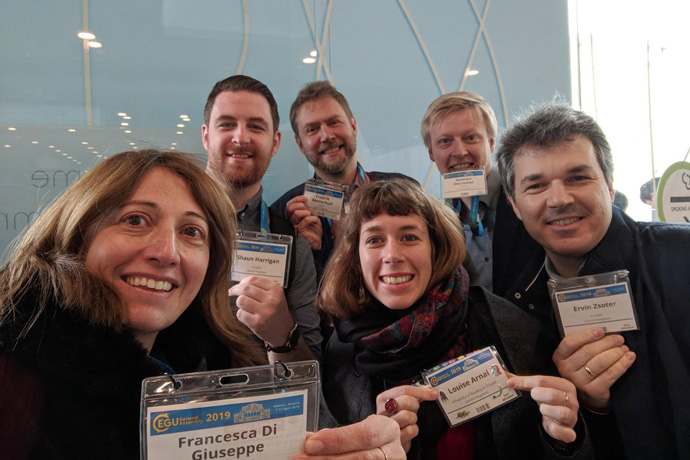
From left to right, Francesca Di Giuseppe, Shaun Harrigan, Fredrik Wetterhall, Louise Arnal, Damien Decremer and Ervin Zsoter were among the ECMWF scientists who attended the EGU meeting.
More than 20 ECMWF scientists set out their latest findings on Earth system processes related to weather, climate and atmospheric composition at the European Geosciences Union (EGU) General Assembly in Vienna, Austria, from 7 to 12 April 2019.
They talked about flood forecasting, wildfire hazards, a new snow scheme, a new land surface analysis and sub-seasonal to seasonal (S2S) predictions. They also presented an EU-funded project to build a prototype system to monitor anthropogenic CO2 emissions.
The two Copernicus services implemented by ECMWF on behalf of the EU were strongly represented. The Copernicus Climate Change Service (C3S) unveiled its European State of the Climate 2018 report, while Copernicus Atmosphere Monitoring Service (CAMS) scientists talked about new Sentinel-5P satellite data and atmospheric composition reanalysis.
The event was attended by more than 16,000 scientists from more than 100 countries.

Freja Vamborg (centre) presented the European State of the Climate 2018 report at a press conference during the EGU General Assembly. (EGU video still)
Floods, fire, snow, land surface and S2S
Fredrik Wetterhall chaired a session on hydro-meteorological forecasts including talks on flash floods, seasonal forecasts of drought and decision-making games.
“The session was very popular,” Fredrik says. “It was clear that hydro-meteorological ensemble forecasts are now very well established in the forecasting community, but there is still work to do to bridge the gap between forecasters and decision-makers.”
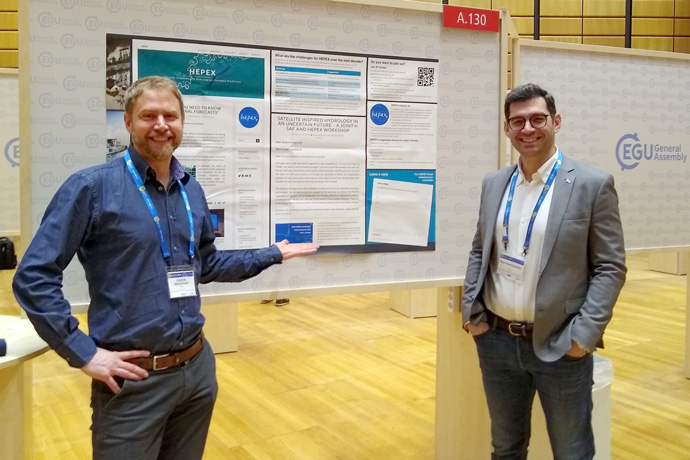
Fredrik Wetterhall (left) co-presented a poster on HEPEX (Hydrological Ensemble Prediction Experiment). The HEPEX community is a network of scientists and practitioners who aim to promote and develop ensemble hydrological forecasting.
Louise Arnal gave a talk on seasonal hydro-meteorological forecast performance for the Danube 2013 floods. “While some hydro-meteorological wetter-than-normal signal was picked up on a seasonal timescale, further work needs to be done on the interplay of hydro-meteorological predictability and sources of uncertainty.”

Louise Arnal’s talk focused on forecast performance.
Shaun Harrigan presented an evaluation of the skill of the Global Flood Awareness System (GloFAS), which is part of the EU-funded Copernicus Emergency Management Service (CEMS) and for which ECMWF is the computational centre. “Scientists from several operational centres and research institutes were interested in using GloFAS,” he notes.
Damien Decremer gave a talk on the latest calibration method to be used in the European Flood Awareness System (EFAS), which is also part of CEMS and for which ECMWF is the computational centre. “There was a lot of interest from the community in the scientific aspects and the challenges of operational implementation,” Damien says.
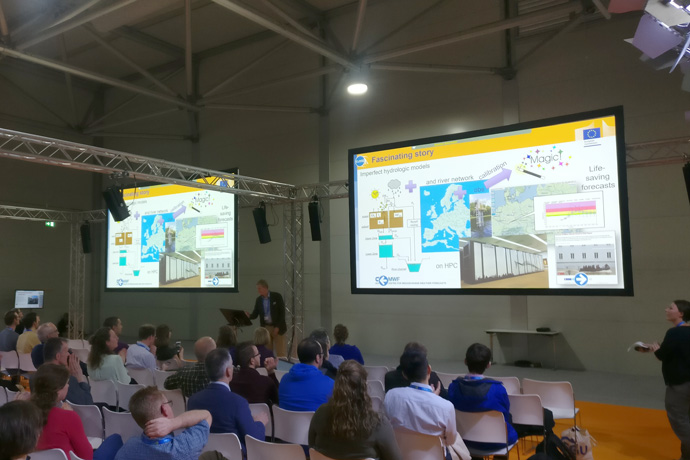
Damien Decremer’s presentation on a new flood forecast calibration method attracted a large audience.
Claudia Vitolo presented a poster on 'Mapping combined wildfire and heat stress hazards to improve evidence-based decision making'. "Several people were interested in reusing the methodology presented for multi-hazard mapping and assessment," she says.
Gabriele Arduini presented the results of tests of a new multi-layer snow scheme at different forecast ranges. “The results look promising for coupled 10-day forecasts of snow depth and two-metre temperature, so we are hopeful that the scheme can be introduced into operations in the not-too-distant future,” Gabriele says.

Gabriele Arduini talked about impacts and evaluation results for a 'multi-layer snow scheme for NWP applications'.
David Fairbairn presented an evaluation of the new stand-alone land surface analysis at ECMWF. “The stand-alone surface analysis incorporates land–atmosphere coupling at a much-reduced computational cost compared with weakly coupled land–atmosphere data assimilation. It is very promising for research and reanalysis activities at ECMWF and elsewhere,” David notes.
Francesca Di Giuseppe convened a session on S2S prediction, focusing on meteorology and impacts. “With 50 abstracts submitted, the session proved very popular and brought together contributions spanning all aspects of S2S meteorological, hydrological and oceanographic prediction, including impacts studies,” Francesca says.
Angela Benedetti gave a presentation at the Union Symposium organised by the WMO to mark the 30th anniversary of the Global Atmosphere Watch. "The talk was on the close linkage between weather and atmospheric composition and was well received by the audience," Angela says.
CHE
Deputy Head of CAMS Richard Engelen prepared a poster giving an overview of the EU-funded CO2 Human Emissions project (CHE), coordinated by ECMWF, which Gianpaolo Balsamo presented. Margarita Choulga and Joe McNorton also presented posters on the project.
“All three posters proved extremely popular, with visitors coming even before the start and after the end of the poster session,” Margarita notes.
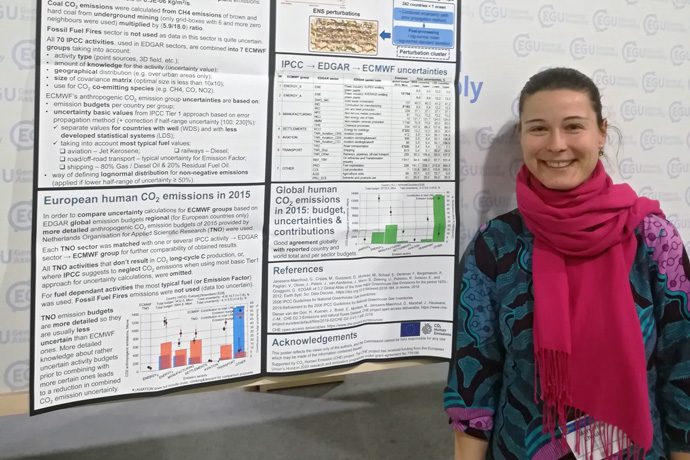
Margarita Choulga presented one of the CHE posters shown at the EGU meeting.
Gianpaolo also gave the well-attended opening talk in a session on ‘Science-based Greenhouse Gas Emission Estimates in Support of National and Sub-National Climate Change Mitigation’ on behalf of Greet Maenhout (Joint Research Centre) from the EU CO2 Task Force.
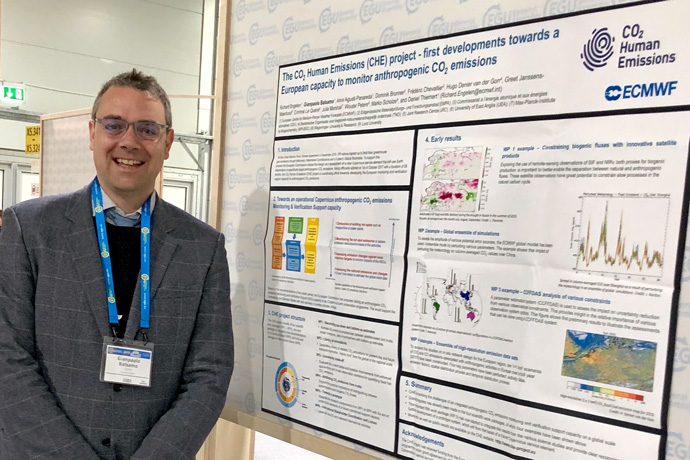
Gianpaolo Balsamo gave an overview of the CHE project.
C3S and CAMS
Head of C3S Jean-Noël Thépaut presented the Copernicus services implemented by ECMWF in a session entitled ‘Climate Services: Underpinning science’. A recurring question was how to access seasonal forecast data on the C3S Climate Data Store at native resolution.
“Discussions on the sidelines of the session showed that there is a growing demand to make a copy or subset of ECMWF’s new ERA5 reanalysis available for local or regional distribution,” Jean-Noël says.
Freja Vamborg presented the C3S European State of the Climate 2018 report at a press conference. The full report is available on the C3S website.

Hans Hersbach explained that ECMWF's new ERA5 reanalysis provides a comprehensive dataset for climate variability, trends and extremes, and Joaquín Muñoz Sabater gave an overview of C3S Earth Observation activities, focusing on data rescue, the reprocessing of fundamental satellite data records, and the production of consistent climate records of Essential Climate Variables.
For CAMS, Antje Inness gave a talk on the use of data from the Sentinel-5P satellite, which is part of the EU’s Copernicus Earth observation programme, in the CAMS data assimilation system.
Johannes Flemming co-convened a session on coupled modelling and data assimilation of the dynamics and chemistry of the atmosphere, and Johannes and others presented a poster on the challenges and opportunities of atmospheric composition reanalysis to represent trends in tropospheric ozone and carbon monoxide.
The EGU General Assembly was a valuable opportunity to share results and ideas with colleagues from across the world. Looking ahead, ECMWF staff will be attending the AGU Fall Meeting (December 2019) in San Francisco, California, USA, where for the first time ECMWF will also have a booth in the exhibition hall where we hope to meet many of you.
